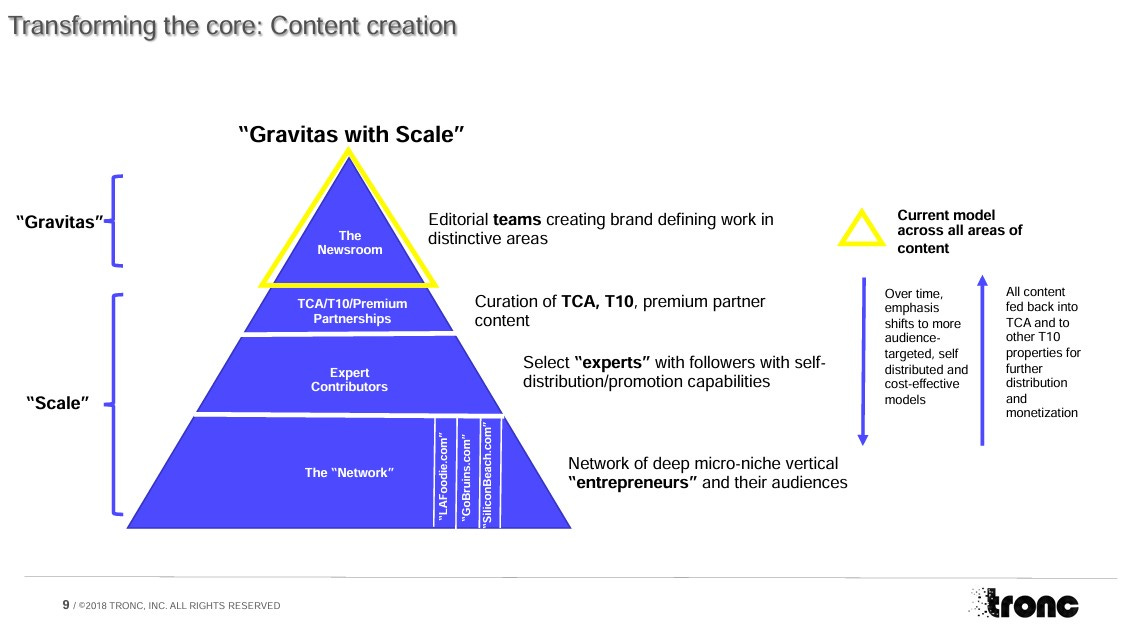Washington Post tries Tronc...?
It's gravitas. But with scale.

I don’t mean to unduly alarm anyone. But amid the leadership shuffle at the Washington Post — Sally Buzbee out, Matt Murray in — my antenna started vibrating at CEO Will Lewis’ memo to staff about an impending reorganization that would create not one (news), not two (news + opinion), but three (news + opinion + ???) newsrooms:
"I am excited to let you know that later this year we will be launching a new division of the newsroom entirely dedicated to better serving audiences who want to consume and pay for news differently from traditional offerings. This third newsroom will be comprised of service and social media journalism and run separately from the core news operation. The aim is to give the millions of Americans -- who feel traditional news is not for them but still want to be kept informed -- compelling, exciting and accurate news where they are and in the style that they want. …
"This third newsroom will help us achieve this by focusing more on video storytelling, embracing AI to help, and flexible payment methods... The new newsroom structure will also allow the core news division to focus entirely on growing The Washington Post subscriber base and building a new suite of professional products - Pro, Plus and Membership."
In a testy town hall with his rightfully skeptical journalists (all solidarity with the Washington Post Guild, by the way), Lewis added: “We are losing large amounts of money [$77 million in the last year]. Your audience is halved. People are not reading your stuff. I can’t sugarcoat it anymore.”
I’ve seen parts of this movie before: A prestigious legacy newsroom that has undergone major staff cuts but retains it proud Golden Age journalistic core. A new management team of cronyish outsiders that wants to shake everything up and unlock vast untapped audiences. A weird duplicate newsroom that will do digital stuff you might expect a regular newsroom might do… except this time profitably!
That’s right, I’m talking about the Tronc era at the Los Angeles Times.
Amid a cinematic sequence of a dramatic union campaign unfolding under a wave of management repression and ineptitude at The Times, it might be hard to remember that Tronc had an actual business plan: a scheme, if you will, in a the shape of a three-sided pyramid, that involved a little pyramid of existing journalists doing boring regular journalism on top of a bigger pyramid of deep micro-niche vertical entrepreneurs and their audiences doing digital stuff. It was called “Gravitas with Scale.”
Gravitas With Scale entailed secretly building a shadow newsroom filled with scabs, and having lived through the era, I can tell you that everyone loved the innovative idea. As the Huffington Post reported at the time:
“HuffPost spoke with 12 current and former Times employees, all of whom asked to remain anonymous for fear of retribution. They described an atmosphere of intense secrecy, distrust and anxiety as they try to get to the bottom of a story they’re living instead of reporting: What exactly does Tronc have in store for them? ‘The newsroom has basically become a large-scale intelligence operation to figure out what the fuck our managers are up to,’ one current employee explained.”
(It was me: I was current employee.)
Look. I have to believe, both out of logic and out of optimism, that this Washington Post bunch is way too smart to try to recreate Tronc’s AI-powered content funnel of deep-networked micropreneurs.
If I had to speculate seriously, Washington Post executives might be thinking of cordoning their excellent journalists behind ever-higher paywalls for the D.C. insider audience for whom subscription pricing is more elastic (just charge it to Deloitte) while the Post simultaneously lets loose a more public-facing and camera-ready army of lower-paid twentysomethings on YouTube or something in concert with a new sort of micropayments system that won’t accidentally siphon away the Post’s existing recurring-subscription base.
But as somebody who worked hard to become both an old-school reporter and a meet-them-wherever-they-are overposter, I have become increasingly skeptical of wagers on the latter to sustain the former, or even the ability of the latter to sustain itself.
The increasingly post-hyperlink architecture of the internet, which no newsroom controls, is hostile to the creation of most content you can make money from. I’d kill for mainstream newsrooms to figure out how to produce and support some more Jenny Nicholsons. But being Jenny Nicholson means sometimes you need two years to make a really, really good YouTube essay, and even then you’re still at the mercy of a monopolistic third-party distributor that can shut off the audience spigot whenever it likes.
“With all my videos, I’m always like, ‘I hope the algorithm still shows it to people; I hope people still click on it,’” Nicholson told Rolling Stone after her recent four-hour review of the dead Star Wars hotel notched millions of viewers. “I have a loyal viewership base, and my channel has like 1 million subscribers, so I was like, ‘OK, it’s probably gonna get 1 million views. So at least there’s that.’ But you’re always kind of at the mercy of YouTube and word of mouth.”
It is the moral duty of every journalist not just to be good, but to be better. But the war against hostile internet infrastructure isn’t going to be won inside the newsroom with the latest buzzy audience initiative. It’s going to be won someplace uncomfortable: out there.



I love a good oxymoronic corporate catchphrase. ChatGPT has the following suggestions for improving upon “Gravitas with Scale”:
Velocity with Veracity (kinda dig it)
Integrity with Infiltration (lol)
Quality with Quantity (LOL)
I worked for a TV station which once got a new boss and refocused our reporting around "advocacy with attitude." This was in 2007. A year later, we gave it up and went hardcore on things like "mortgage-backed securities" and such.